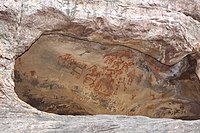
Photo from wikipedia
Abstract Clastic successions in rock shelters commonly host important archaeological findings, especially of prehistoric and protostoric times. The understanding of depositional and post-depositional processes in these environments is crucial to… Click to show full abstract
Abstract Clastic successions in rock shelters commonly host important archaeological findings, especially of prehistoric and protostoric times. The understanding of depositional and post-depositional processes in these environments is crucial to understand the lifestyle settings of humans, as well as the reliability of archaeological data obtained during excavations. Rock shelters are genetically related to caves, but while depositional processes in caves are generally well known, less information is available concerning the depositional processes active in rock shelters. This paper tries to contribute to this issue, describing the sedimentary succession exposed at the Oscurusciuto rock shelter (Ginosa, Southern Italy). This is one of the most important Middle Palaeolithic sites of the Italian peninsula, and its sedimentary infill hosts witnesses of very late Neanderthal populations that lived in Italy just before their total decline and complete replacement by Modern Humans (MH). This work presents the results of a sedimentologically based study integrated with an ichnological study of selected beds. The combination of these two methodologies allowed us to: (i) define the main depositional processes active in the rock shelter environment, as well as the relationships between different processes; (ii) discuss the meaning of peculiar ichnofabrics recognized at the site, and (iii) discuss the meaning of structureless strata at an archeological site in the framework of human trampling vs bioturbation as a cause of the obliteration of primary sedimentary structures.
Journal Title: Geological Magazine
Year Published: 2020
Link to full text (if available)
Share on Social Media: Sign Up to like & get
recommendations!